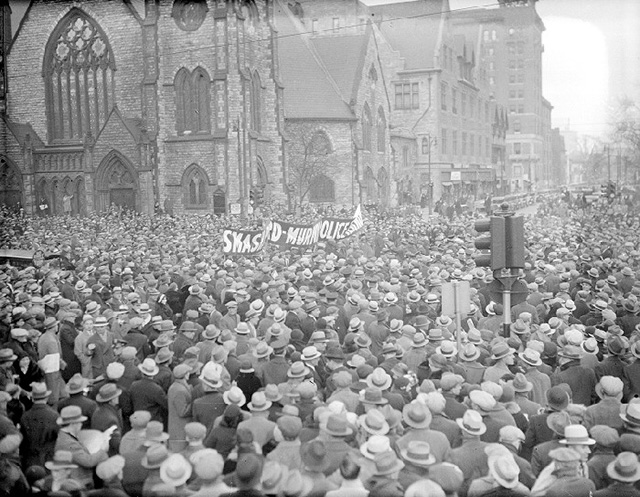
Woodmere Cemetery also holds memories of the 1932 Ford Hunger March, a fatal confrontation between laid-off autoworkers and the Ford Motor Company. The hard times of the Great Depression, which began in 1929, shook Detroit. The depression’s impact could mean ruin for auto magnates and financiers and starvation and misery for factory hands. In February 1929, the Ford Motor Company had a payroll 98,939 workers. When the company closed for retooling in 1931, only 37,000 remained on its payroll. The average annual wages of Michigan autoworkers fell by almost 50% between 1929 and 1932. Unemployment in Detroit was estimated to be 50% in 1932, and as many as 100,000 people left Detroit to seek work elsewhere in this period. Private charities were overwhelmed and bank failures further undercut relief efforts. Led by Mayor Frank Murphy, the City of Detroit provided some relief, including shelters, food, and apple-vending licenses. Significantly, the Murphy administration broke down racial barriers by extending aid to Detroit’s African American population. But the city’s coffers were soon empty, and Franklin Roosevelt’s New Deal was still over a year away.
For many, it seemed that “Open Shop” Detroit and industrial capitalism were on the brink of collapse. Members of the Communist Party created Unemployed Councils to resist evictions and demand government support by protesting at local welfare offices. Although the Councils remained closely tied to the Communist Party, they worked with a variety of radical, liberal, and religious organizations to focus attention on the plight of the unemployed. They also earned the respect of the African American community for welcoming blacks among their ranks and championing the cause of the Scottsboro Boys, young black teenagers who were falsely accused of rape in Jim Crow Alabama.
On March 7, 1932, a bitterly cold day, the Detroit Unemployed Councils led more than 3,000 people on a march from Southwest Detroit to the Ford Rouge Plant, in nearby Dearborn, to demand jobs, better conditions for those still at work, and relief for those who remained laid off. A confrontation with police officers and firefighters at the Fort Street Bridge, on the Detroit-Dearborn border, failed to stop the march. When the protesters reached Gate Four at the Rouge, Dearborn police officers and Ford security personnel attacked them, firing several hundred shots and killing four marchers. A fifth died later of injuries suffered that day. A number of hunger marchers threw rocks and clods of frozen mud, breaking employment office windows and injuring fifteen police officers. Sixty marchers were wounded in addition to those who were killed. Numerous protesters with gunshot wounds were arrested and chained to their hospital beds, while police officers raided the headquarters of the Unemployed Councils.
 Hunger March Funeral Procession – Grand Circus Park
Hunger March Funeral Procession – Grand Circus Park
The four protesters killed at the Rouge on March 7—Joe York, Coleman Leny, Joe DeBlasio, and Joe Bussell—were buried in Woodmere Cemetery in a common, unmarked grave within sight of the Ford complex. Demonstrating strong community support for the Hunger Marchers, an estimated sixty thousand Detroiters participated in their funeral procession down Woodward Avenue. The fifth marcher who died, Curtis Williams, was African American, and Woodmere Cemetery’s strict segregation policy prevented his burial there. No Ford or Dearborn officials were prosecuted for the deaths caused by the gunfire on that cold March day. It took nearly fifty years before the Rouge Plant’s UAW Local 600 retiree organization was permitted to place headstones at the slain marchers’ gravesite, including one for Curtis Williams.
A State of Michigan Historic Marker that commemorates the attack on the Hunger Marchers that had been placed on the original bridge has been reinstalled near the UAW Ford Local 600 Dix Street entrance after the original span was replaced. In addition, the Motor Cities National Heritage Area and its community partners placed a “Wayside” interpretive sign, on the south side of Dix, just outside Woodmere Cemetery’s northern fence as a reminder of those difficult times.
Click to view:
Woodmere Cemetery Information / Auto Pioneer Profiles:
Woodmere Cemetery List of Notables Gail Hershenzon’s list of distinguished citizens interred at the Cemetery, originally posted to Woodmere Cemetery Research website.
David Dunbar Buick, Jim Donnelly’s biographical profile from Hemmings Classic Car magazine website
Detroit's Olympics bid brought Matthaei to WSU, an account of how Frederick Matthei’s efforts to host the Olympics led to the development of Wayne State University’s athletic facilities.
LINCOLN MOTOR COMPANY and HENRY LELAND, the Guide’s features that chronicle Henry Leland’s career
Hunger March Accounts
Dave Moore - Labor Minute, this DPTV /WTVS video shares the insights of a Hunger Marcher, UAW officer, and Civil Rights activist
The Ford Hunger March: Five Martyrs for Justice, Jim Pita’s Michigan Labor History Society newsletter feature
Ford Hunger March, Kristen Chinery’s discussion from the Walter Reuther Library website.
Fort St. Bridge Interpretive Park this initiative spearheaded by MotorCities, the Fort-Rouge Gateway Coalition (FRoG), and the Friends of the Rouge reclaims the natural habitat of the lower Rouge River and commemorates the Hunger March following the Michigan Department of Transportation’s reconstruction of the bridge.
TEXT & RESEARCH – RON ALPERN & DIANNE FEELEY



